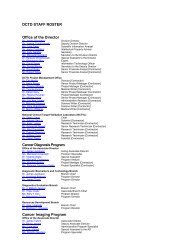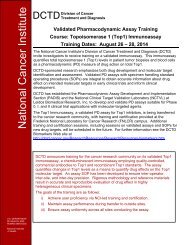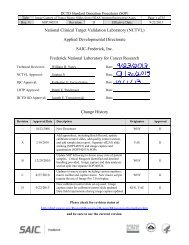National Cancer Institute - NCI Division of Cancer Treatment and ...
National Cancer Institute - NCI Division of Cancer Treatment and ...
National Cancer Institute - NCI Division of Cancer Treatment and ...
Create successful ePaper yourself
Turn your PDF publications into a flip-book with our unique Google optimized e-Paper software.
Co-Development <strong>of</strong> Diagnostics<br />
<strong>and</strong> Therapeutics: Using<br />
Biomarkers for Personalization<br />
<strong>of</strong> <strong>Treatment</strong><br />
During 2004, Dr. Simon published two<br />
papers that demonstrated the vast<br />
improvement in efficiency <strong>of</strong> r<strong>and</strong>omized<br />
phase III trials that can be achieved from<br />
using a biomarker or genomic classifier<br />
to select patients likely to respond to the<br />
new treatment. In many cases, however,<br />
such classifiers are not available at the<br />
start <strong>of</strong> phase III trials. During 2005,<br />
Drs. Freidlin <strong>and</strong> Simon published a<br />
new phase III design that addressed this<br />
limitation. The design does not limit entry<br />
based on a biomarker but requires that<br />
tumor specimens be collected at the time<br />
<strong>of</strong> entry. At the end <strong>of</strong> the trial, outcomes<br />
for all patients on the new treatment<br />
are compared to those for all patients<br />
on the control. If the difference is significant<br />
at a level <strong>of</strong> 0.04 or better, results<br />
are taken to support approval <strong>of</strong> the<br />
new drug with a broad labeling indication.<br />
If not, then the specimens from the first<br />
half <strong>of</strong> patients r<strong>and</strong>omized are used to<br />
develop a classifier <strong>of</strong> which patients<br />
appear to benefit from the new regimen.<br />
That classifier is then applied to the<br />
second half <strong>of</strong> the r<strong>and</strong>omized patients,<br />
<strong>and</strong> those predicted to be sensitive to<br />
the new treatment are identified. If the<br />
outcomes for patients in that subset<br />
on the new treatment are significantly<br />
better than for the control patients in<br />
the subset <strong>and</strong> if the significance level<br />
is 0.01 or less, then the data are taken to<br />
support approval with a narrowed labeling<br />
indication for the new treatment.<br />
S C I E N T I F I C A D V A N C E S<br />
Freidlin B, Simon R. Adaptive signature design:<br />
an adaptive clinical trial design for generating<br />
<strong>and</strong> prospectively testing a gene expression<br />
signature for sensitive patients. Clin <strong>Cancer</strong> Res<br />
2005:11;7872–8.<br />
Dr. Simon has interacted with scientists<br />
from industry <strong>and</strong> the Food <strong>and</strong> Drug<br />
Administration (FDA) in numerous scientific<br />
workshops <strong>and</strong> seminars to develop<br />
effective approaches to the development<br />
<strong>and</strong> evaluation <strong>of</strong> biomarker classifiers<br />
that identify patients who respond to<br />
particular therapeutics. In order to facilitate<br />
the application <strong>of</strong> this approach,<br />
Dr. Simon has established formal pharmacogenomic<br />
agreements with Johnson<br />
& Johnson Pharmaceutical Research &<br />
Development <strong>and</strong> Centicor.<br />
Simon R. Roadmap for developing <strong>and</strong> validating<br />
therapeutically relevant genomic classifiers.<br />
J Clin Oncol 2005:23;7332–41.<br />
Simon R, Wang SJ. Use <strong>of</strong> genomic signatures<br />
in therapeutics development in oncology <strong>and</strong><br />
other diseases. Pharmacogenomics J (In press).<br />
Trepicchio WL, Essayan D, Hall ST, Schechter G,<br />
Tezak Z, Wang SJ, Weinrich D, Simon R. Designing<br />
prospective clinical pharmacogenomic trials.<br />
Effective use <strong>of</strong> genomic biomarkers for use in<br />
clinical decision making. Pharmacogenomics J<br />
(In press).<br />
Simon R. Validation <strong>of</strong> pharmacogenomic<br />
biomarker classifiers for treatment selection.<br />
Dis Markers (In press).<br />
Simon R. A checklist for evaluating reports <strong>of</strong><br />
expression pr<strong>of</strong>iling for treatment selection.<br />
Clin Adv Hematol Oncol (In press).<br />
Simon R. Guidelines for the design <strong>of</strong> clinical<br />
studies for development <strong>and</strong> validation <strong>of</strong><br />
therapeutically relevant biomarkers <strong>and</strong><br />
biomarker based classification systems. In:<br />
Biomarkers in Breast <strong>Cancer</strong>: Molecular Diagnostics<br />
for Predicting <strong>and</strong> Monitoring Therapeutic Effect.<br />
Hayes DF, Gasparini G, eds. Totawa, NJ: Humana<br />
Press; 2005.<br />
B I O M E T R I C R E S E A R C H B R A N C H ■ 17










